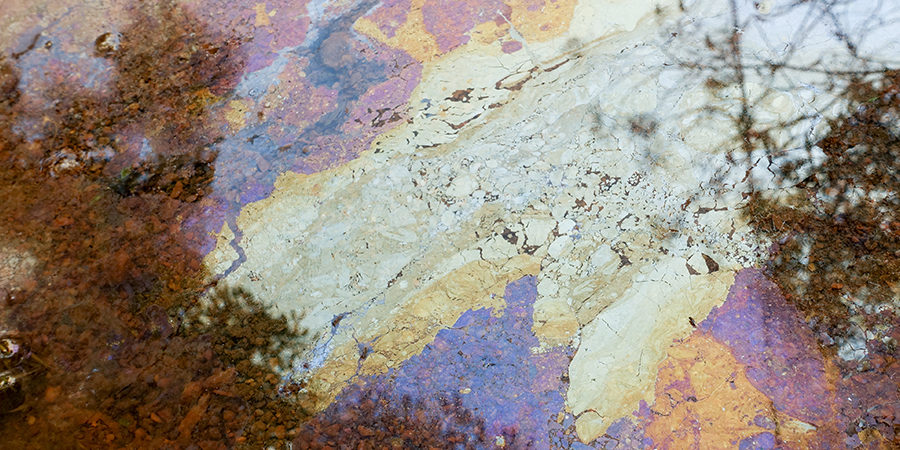In certain soil remediation projects, there can be a need for purification of exhaust from air strippers, tent ventilation and even the interstitial air in the ground present naturally or under purge from treatment systems.
Air Strippers
The pump and treat method is a technology often used in soil remediation projects where contaminated groundwater is extracted by pumping the water from the soil. This technology is always associated with treatment technologies such as air stripping or water treatment using activated carbon.
Air stripping is a technology in which water and air are intensively brought into contact with each other. This causes the volatile compounds present in the water to be transferred into the air. The VOC laden air must be treated in an air treatment system like an EcoFlow™ mobile filter.
The following volatile organic compounds are primarily removed when stripping groundwater:
- Aromatic compounds (BTEX)
- Benzene
- Toluene
- Ethyl benzene
- Xylene
- Volatile chlorinated hydrocarbons as indicated in table 1
- Table 1: Examples of Volatile chlorinated hydrocarbons
IUPAC Name Chemical formula Is also called 1,1,1-trichloroethane C₂H₃Cl₃ Methylchloroform 1,2-dichloroethane C₂H₄Cl₂ Ethylene dichloride, EDC Chloroethane C₂H₅Cl Ethyl chloride Chloromethane CH₃Cl Methyl chloride Dichloromethane CH₂Cl₂ Methylene chloride, DCM Tetrachloroethene C₂Cl₂ Tetrachloroethene, perchloroethylene, PER Tetrachloromethane CCl₄ Carbon tetrachloride, CTC Trichloroethene C₂HCl₃ Trichloroethylene, TCE, TRI Trichloromethane CHCl₃ Chloroform, TCA - Methylene chloride
- Per halogenated compounds (PER)
- Tetrachloro methane
- Trichloro ethene
- Etc.
- Table 1: Examples of Volatile chlorinated hydrocarbons
- Aliphatic hydrocarbons
- Cyclohexane
- Pentane
- Hexane
Please contact us if you need specific advice on compounds that are not in above list.
Air treatment during ground excavation
Ground excavation is needed when an ex-situ soil remediation process is selected. In cases where the excavated soil contains a volatile and/or toxic pollutant, the excavation process is performed under a tent. This tent is usually equipped with an air treatment system using mobile activated carbon filters that will ensure the safety of employees and the surrounding area.
Soil vapour extraction (SVE)
Soil vapour extraction (SVE) is a physical treatment process for in situ soil remediation of volatile contaminants. The technology is also referred to as in situ soil venting or vacuum extraction. The contaminants accumulated on the solids and liquid of the soil are transferred into the gas phase. The air may be heated to increase the volatility of the substances to be removed. The contaminant-laden air is collected at extraction wells and then treated to remove the impurities with processes such as activated carbon adsorption.
How are impurities removed from the air in soil remediation projects?
Ground water remediation contractors often use mobile filter type EcoFlow™ filled with activated carbon because
- Remediation jobs are limited in time
- Different remediation jobs often require different mobile filters
- On site spent carbon handling is often cumbersome and a closed loop solution is preferred
- Designed for low pressure drop and excellent flow distribution
- The EcoFlow™ range are available in different sizes to treat different flow ranges
Jacobi Services offers a wide range of EcoFlow™ mobile filters for air treatment capable of handling flowrates up to 40,000m³/h per filter including the suitable activated carbon for such an application. Contact our application specialists to help select a cost-effective activated carbon solution or for more information on inorganics or organics removal from air.
What can we do with spent activated carbon from soil remediation projects?
The Jacobi adsorbents are used in a wide range of applications. Adsorbents generally have a limited lifetime and need to be replaced once they are saturated or the treatment objective is reached. Jacobi Services offers several recycling, energy recovery or disposal services in different facilities, depending on the properties of the spent material.
It is well known that adsorption of aldehydes and ketones can cause hotspot. Please contact us to obtain specialist information on the adsorption of these problematic compounds.


